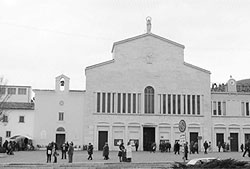 |
 |
|||||
 |
 |
 |
 |
 |
||||||||||||
 |
 |
|||||||||||
| Padre Pio (pictured at left) received the stigmata in the small 17th-century church in the southern Italian village of San Giovanni Rotondo. He later built the larger adjacent church, where he is now buried, to accommodate the large numbers of pilgrims that flocked to see him. CNS
Veteran leader brings sense of stability to school
Stigmata, the distinct sign of Christ’s passion, are at the center of a theological debate. Beginning with Francis of Assisi, and up to and including modern figures such as Blessed Pio of Pietrelcina, there have been about 250 apparently authentic cases of individuals with stigmata. The church has never issued any infallible declaration about their possession by anyone. Yet, what could be the meaning of these painful wounds in the hands and feet of persons who in some cases have changed the course of history and Christianity? Zenit, a Rome-based news service with close Vatican ties, interviewed Passionist Father Tito Paolo Zecca, professor of pastoral theology and spirituality at the Pontifical Lateran University and the Pontifical Antonianum Atheneum of Rome, in order to better understand the debate. Zecca has written books on the topic and is one of the leading experts on the subject. Z: What is the meaning of stigmata? PZ: The Gospel shows that, in the mystery of Jesus’ resurrection, the wounds did not disappear. Stigmata are a sign of what Christ suffered during the passion; therefore, they are theological data that need far more study than has been done to date. In John’s Gospel, when Jesus enters the Cenacle through closed doors and greets the disciples, he shows them the stigmata in order to identify himself. He told St. Thomas: “Put your finger in my side.” The apostles’ consternation is also a revealing fact of this mystery. This phenomenon shows the efficacy of Christ’s salvation on the cross, and it remains in a special way in the sign of the stigmata, becoming a distinctive fact of the redeeming and saving efficacy of the faith. Z: There have been 250 cases of saints and blessed who have had the stigmata. What is the historical meaning of this sign? PZ: It is a particular [phenomenon] of Western spirituality and mysticism. Since St. Francis, we have had a significant number of saints and blessed who have lived the disconcerting experience of reproducing Christ’s stigmata in their bodies. To date, research has emphasized the character of configuration and imitation of Jesus, which stems from the intense personal relation that these persons had with him. However, there has been very little analysis of the role these saints and blessed had in the Church. There has been insufficient reflection on the particular mission connected with the stigmata. Z: Can you give a concrete case? PZ: For example, St. Francis of Assisi received the stigmata when all his holy plans—foundation of the order, approval of the primitive rule, journey to Palestine—had failed. He was alone and abandoned. He was consoled by being configured with the Crucified, yet, simultaneously, the suffering of the stigmata became a good for the order and a message for the whole church. St. Francis’ successor, Friar Elias, understood the meaning of the stigmata, and emphasized this in his letter to all the faithful. This same message and mission of the stigmata can be seen in St. Mary Magdalene of Pazzi and St. Catherine of Siena. In the century that just ended, this mission was clearly seen in persons like St. Gemma Galgani [died in 1913], Blessed Padre Pio of Pietrelcina [1887-1968], and Marthe Robin [French mystic, who died in 1981, whose writings are being studied before beginning her process of beatification]. Marthe Robin became known after famous writer Jean Guitton wrote the book “The Motionless Journey.” Marthe Robin was bedridden for 40 years. Like Gemma Galgani and Padre Pio, she inspired many groups of spirituality and prayer around the world. Z: What does a person who receives the stigmata of Christ’s passion feel? PZ: It is an experience of joy and pain. The Lord is always the one who takes the initiative. The recipients of stigmata regard this as an immense grace, of which they feel unworthy. In fact, they ask the Lord to take them away, because they are embarrassed. This attitude was evident in Padre Pio. The blessed of Pietrelcina shows clearly what the mission is, of those who bear the stigmata. Padre Pio founded prayer groups and the Home for the Relief of Suffering, a great hospital, doing a specific work to alleviate physical sufferings. Moreover, the intercessory capacity of persons bearing stigmata is greater, united with others in prayer, in the renewal, salvation and protection of the world. Z: But, why does the Lord give this “grace” to certain people? PZ: The answer is, precisely, in their mission. It is a service the church needs in a particular moment of its history. It is like a prophetic sign, a call, a surprising fact capable of reminding men about what is essential, namely, to be conformed to Christ, and of Christ’s salvation who rescued us by his wounds. In a certain sense, all of us bear the stigmata, because in baptism we are submerged in Christ’s life, which enables us to participate in the paschal mystery of his death and resurrection. In our own little way, each one of us bears the stigmata. If we bear them with the spirit of faith, hope, courage and fortitude, these wounds, which can be purulent and never heal, can help to cure others. In a word, the stigmata represent the conscious acceptance of the cross, lived spiritually. For books regarding Padre Pio, see advertisments on Pages 19 and 22.
Front Page | Digest | Cardinal | Interview |
||||||||||||